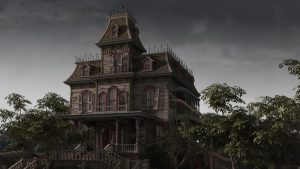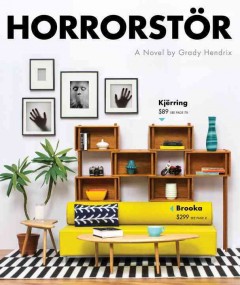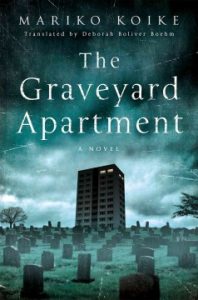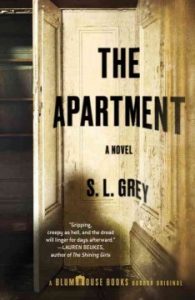This week, we’ve been talking about the haunted house in literature, and detailing the kinds of haunted houses that one can find in traditional horror novels/ghost stories/All-Hallows Read selections.

But as I was working on these posts, it occurred to me how many other kinds of haunted sites have been cropping up in fiction, especially lately. According to many scholars of genre, the horror novel is entering a new phase, that isn’t wholly defined as yet. Some of its core themes, however, deal with 1) our growing unease with the unknown, especially amidst the information explosion brought about by the internet, 2) a kind of existentialist despair–being faced with the realities and future threats of global climate change, nuclear armageddon, and other issues over which we have comparatively little control has introduced the fear that perhaps doom is inevitable. That perhaps we can’t vanquish all the monsters with technology and fortitude. Whether these genre tropes will grow and mature into a new era of horror has yet to be seen. But what we do know is that we’ve already been treated to a host of horror novels that up-end conventions, while still providing the fears, dreads, and very human journeys that make horror novels so pleasurable to read.

One of the noticeable themes that these books overturn is the notion of the haunted house. In an age where fewer people are buying houses, it makes sense that the living situations reflected in horror novels needs to change, too. You can’t really be scared of something if you have no frame of reference. But while some of these books looks at a haunted apartment building, others keep pushing the line, giving us haunted superstores and haunted ships. They enrich our thinking about the spaces we inhabit and the memories they carry inside them. They challenge us to remember, even as we are told to look forward to the future, to not be held back by the past. They also allow us to explore the dark secrets and troubling pasts that our characters carry with them, and how our own personal darkness can affect our perception of the world and each other. No longer are our characters hapless victims of the spirit world–they are the dry charge themselves that make the spaces ugly and scary by bringing their very real-world ugliness and scariness into it.
So what are some of these new haunted spaces? Take a look below and see what you think!
 Horrorstör: Grady Hendrix is a really interesting author, who plays with conventions while still delivering interesting and engaging stories. He’s also written a book that is laid out like a high school year book, which is perfect for those with 1980’s nostalgia. But this book is very much of the moment, set in a generic Ikea, known as the Orsk furniture superstore. Strange things have been going on in this Cleveland store, but when three employees volunteer to work an overnight shift to investigate, but what they discover is more horrifying than they could have imagined. This book is a model of good design (thanks to designer Andie Reid, illustrator Michael Rogalski, and cover photographer Christine Ferrara). It is laid out like a glossy catalog, complete with showroom shots and maps of Orsk’s labyrinthine layout, providing a delightful contrast between the ironic and the horrific.
Horrorstör: Grady Hendrix is a really interesting author, who plays with conventions while still delivering interesting and engaging stories. He’s also written a book that is laid out like a high school year book, which is perfect for those with 1980’s nostalgia. But this book is very much of the moment, set in a generic Ikea, known as the Orsk furniture superstore. Strange things have been going on in this Cleveland store, but when three employees volunteer to work an overnight shift to investigate, but what they discover is more horrifying than they could have imagined. This book is a model of good design (thanks to designer Andie Reid, illustrator Michael Rogalski, and cover photographer Christine Ferrara). It is laid out like a glossy catalog, complete with showroom shots and maps of Orsk’s labyrinthine layout, providing a delightful contrast between the ironic and the horrific.
 The Graveyard Apartment: This Japanese horror novel, originally published in 1986, takes us into an enormous apartment building that was constructed next to a graveyard. The young couple and their daughter who move into this household are dealing with their own inner darkness and wrestling with secrets they are fighting to keep hidden. The longer they stay in their new place, though, the stranger and stranger things seem to get. People around them move out one by one, until this small family is left alone in the building. Alone, except for whatever is living in the basement. Mariko Koike is a master of the psychological novel, and this book doesn’t always show, and resists answering all the questions it asks. Instead, it leaves it up to the reader to slide their own fears and doubts to the reading experience, and playing on our inherent fears of the dark and the unknown to create a genuinely chilling reading experience.
The Graveyard Apartment: This Japanese horror novel, originally published in 1986, takes us into an enormous apartment building that was constructed next to a graveyard. The young couple and their daughter who move into this household are dealing with their own inner darkness and wrestling with secrets they are fighting to keep hidden. The longer they stay in their new place, though, the stranger and stranger things seem to get. People around them move out one by one, until this small family is left alone in the building. Alone, except for whatever is living in the basement. Mariko Koike is a master of the psychological novel, and this book doesn’t always show, and resists answering all the questions it asks. Instead, it leaves it up to the reader to slide their own fears and doubts to the reading experience, and playing on our inherent fears of the dark and the unknown to create a genuinely chilling reading experience.
 The Apartment: Another haunted apartment, this one set in the glamor of Paris. This young family and their daughter (is there a trend here?) move from Cape Town after surviving a violent break-in that left them traumatized. At first, the house-swap plan they find sounds perfect. But upon moving to their European haven, they quickly realize that nothing is as advertised. This is a story where the ‘haunting’ is a way to get to the heart of these characters, breaking down their defenses and facades and forcing them to confront each other’s worst (and sometimes best) qualities. This is very much a story about people bringing out the worst, not only in each other, but in the space they inhabit, and that interaction makes it feel very modern, indeed.
The Apartment: Another haunted apartment, this one set in the glamor of Paris. This young family and their daughter (is there a trend here?) move from Cape Town after surviving a violent break-in that left them traumatized. At first, the house-swap plan they find sounds perfect. But upon moving to their European haven, they quickly realize that nothing is as advertised. This is a story where the ‘haunting’ is a way to get to the heart of these characters, breaking down their defenses and facades and forcing them to confront each other’s worst (and sometimes best) qualities. This is very much a story about people bringing out the worst, not only in each other, but in the space they inhabit, and that interaction makes it feel very modern, indeed.
Happy reading, beloved patrons. And Happy All-Hallows Read!
